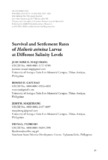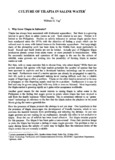Survival and settlement rates of Haliotis asinina larvae at different salinity levels
- Global styles
- MLA
- Vancouver
- Elsevier - Harvard
- APA
- Help
Share
Abstract
The study was conducted to determine the optimum salinity levels (24 ppt, 28 ppt, 32 ppt, 36 ppt and 40 ppt) for the survival and settlement rates of H. asinina in a complete randomized design with three replicates each. The experimental animals were reared in 15 glass aquaria for the first run and in plexiglass for the second run. Feeding of Navicula spp. was done once a day. Temperature and dissolved oxygen were monitored throughout the experiment. Data were analyzed using One-Way ANOVA to determine significant difference among treatments at 0.05 level of significance using Social Package for Social Science. Result of the first run showed that 32 ppt had the highest mean survival (1.50%) and mean settlement rate (1.84%). Similar result was also observed in 32 ppt with highest mean survival (9.72%) and mean settlement rate (16.42%). Significant difference existed among treatments during the second run of the experiment. Results showed that 28 ppt and 32 ppt were the optimum salinity levels for survival and settlement rate of H. asinina. Further study should be conducted to determine the tolerance and settlement rates of H. asinina larvae to lower salinities until it reaches juvenile stage with first respiratory pore appearing.
Suggested Citation
Maquirang, J. R. H., Caturao, R. D., Maquirang, J. H., & Pedroso, F. L. (2013). Survival and settlement rates of Haliotis asinina larvae at different salinity levels. IAMURE International Journal of Ecology and Conservation , 8(1), 81-95. https://doi.org/10.7718/ijec.v8i1.745
Type
ArticleISSN
2244-1573; 2244-1581Collections
- Journal Articles [1258]
Related items
Showing items related by title, author, creator and subject.
-
Growth response of Nile tilapia fry to salinity stress in the presence of an ‘internal reference’ fish
Basiao, Zubaida U.; Eguia, Ruel V.; Doyle, Roger W. (Blackwell Publishing, 2005)Growth of three strains of Oreochromis niloticus L. fry exposed to salinity stress in the presence of an internal reference fish were compared. The Central Luzon State University (CLSU) strain was obtained from the Freshwater ... -
Enrichment of live food with essential fatty acids and vitamin C: effects on milkfish (Chanos chanos) larval performance
Gapasin, R. S. J.; Bombeo, R.; Lavens, P.; Sorgeloos, P.; Nelis, H. (Elsevier, 1998)The effects of essential fatty acids (EFA) and vitamin C-enriched live food on growth, survival, resistance to salinity stress and incidence of deformity in milkfish larvae reared in tanks were investigated. Larvae were ... -
Culture of tilapia in saline water
Yap, Wilfredo G. (University of the Philippines Aquaculture Society, Inc., 2001)





